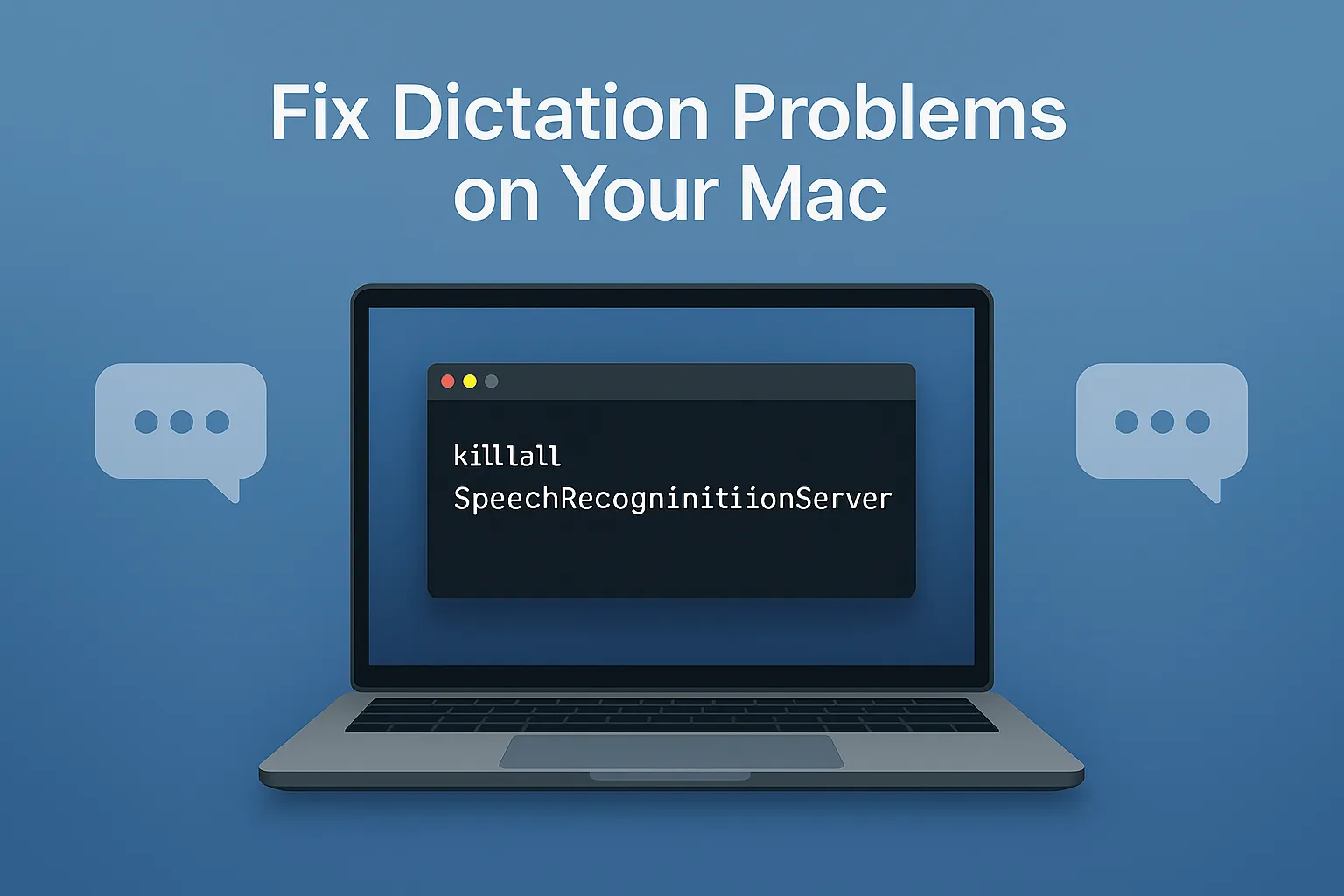Understanding Mac OS Dictation Issues
Before diving into solutions, it’s important to understand what typically causes Dictation problems on macOS. Common symptoms include:
- Dictation not responding when activated
- Voice input not being recognized
- Dictation interface appearing but not processing speech
- System freezing when attempting to use Dictation
- Error messages related to speech recognition services
These issues often stem from corrupted system processes, conflicting applications, or problems with the speech recognition services that power Dictation.
Quick Solution: Terminal Command Fix
The most effective and quickest solution for fixing Mac OS Dictation issues is to restart the speech recognition services using Terminal. This method resolves the majority of Dictation problems without requiring a full system restart.
Step-by-Step Process
1. Open Terminal: Press Command + Space to open Spotlight search, type “Terminal” and press Enter.
2. Execute the Fix Command: Copy and paste the following command into Terminal:
killall -9 DictationIM com.apple.SpeechRecognitionCore.speechrecognitiond com.apple.SpeechRecognitionCore.brokerd3. Press Enter: Execute the command by pressing the Enter key.
4. Wait for Process Completion: The command will terminate the problematic processes. You may see some output in Terminal, which is normal.
5. Test Dictation: Try using Dictation again by pressing the assigned keyboard shortcut (usually Function key twice or Command + Space).
What This Command Does
This terminal command performs several important actions:
- killall -9: Forces termination of specified processes
- DictationIM: Stops the Dictation Input Method process
- com.apple.SpeechRecognitionCore.speechrecognitiond: Terminates the main speech recognition daemon
- com.apple.SpeechRecognitionCore.brokerd: Stops the speech recognition broker service
By killing these processes, macOS will automatically restart them with fresh configurations, often resolving corruption or conflict issues.
Alternative Method: System Restart
If the terminal command doesn’t resolve the issue, a complete system restart is the next recommended step. While this takes longer than the terminal fix, it ensures all system processes are completely refreshed.
When to Use System Restart
Consider restarting your Mac if:
- The terminal command didn’t resolve the issue
- You’re experiencing multiple system-wide problems
- Dictation hasn’t worked for an extended period
- Other voice-related features are also malfunctioning
How to Properly Restart
- Save Your Work: Ensure all documents and files are saved
- Close Applications: Quit all running applications properly
- Restart: Click the Apple menu and select “Restart”
- Wait for Complete Boot: Allow your Mac to fully start up before testing Dictation
Additional Troubleshooting Steps
If both primary solutions don’t work, consider these additional troubleshooting methods:
Check Dictation Settings
- Open System Preferences (or System Settings on newer macOS versions)
- Navigate to Keyboard > Dictation
- Verify that Dictation is enabled
- Check the microphone input settings
- Ensure the correct language is selected
Verify Microphone Permissions
- Go to System Preferences > Security & Privacy > Privacy
- Select Microphone from the left sidebar
- Ensure that applications you want to use with Dictation have microphone access
Reset Speech Recognition
- Open System Preferences > Accessibility > Speech
- Click Speak selection options
- Reset voice and speech settings to defaults
Check for macOS Updates
Outdated system software can cause compatibility issues:
- Click the Apple menu > About This Mac
- Check for available system updates
- Install any pending macOS updates
- Restart your Mac after updating
Prevention Tips
To minimize future Dictation issues:
- Regular Restarts: Restart your Mac weekly to clear temporary files and refresh system processes
- Keep macOS Updated: Install system updates promptly to maintain compatibility
- Monitor Third-Party Apps: Some applications can interfere with system speech services
- Maintain Available Storage: Ensure your Mac has adequate free disk space (at least 10-15% free)
Advanced Troubleshooting
For persistent issues, consider these advanced solutions:
Reset NVRAM/PRAM
- Shut down your Mac completely
- Press and hold
Option + Command + P + Rwhile starting up - Hold these keys for about 20 seconds
- Release the keys and allow normal startup
Safe Mode Boot
- Restart your Mac while holding the
Shiftkey - Release when you see the login screen
- Test Dictation in Safe Mode
- Restart normally if it works in Safe Mode
When to Contact Support
If none of these solutions work, it may indicate:
- Hardware issues with your Mac’s microphone
- Deeper system corruption requiring professional diagnosis
- Compatibility problems with specific hardware configurations
Contact Apple Support or visit an Apple Store for further assistance in these cases.
Conclusion
Mac OS Dictation issues are typically resolved quickly using the terminal command method. This solution addresses the most common causes of speech recognition problems by refreshing the system processes responsible for voice input. The system restart method serves as an effective backup solution when the terminal approach doesn’t work.
By following this troubleshooting guide, you should be able to restore your Mac’s Dictation functionality and continue using voice input efficiently. Remember to keep your system updated and perform regular maintenance to prevent similar issues in the future.
Most users find that the terminal command fix resolves their Dictation problems immediately, making it the preferred first-line solution for this common macOS issue.
